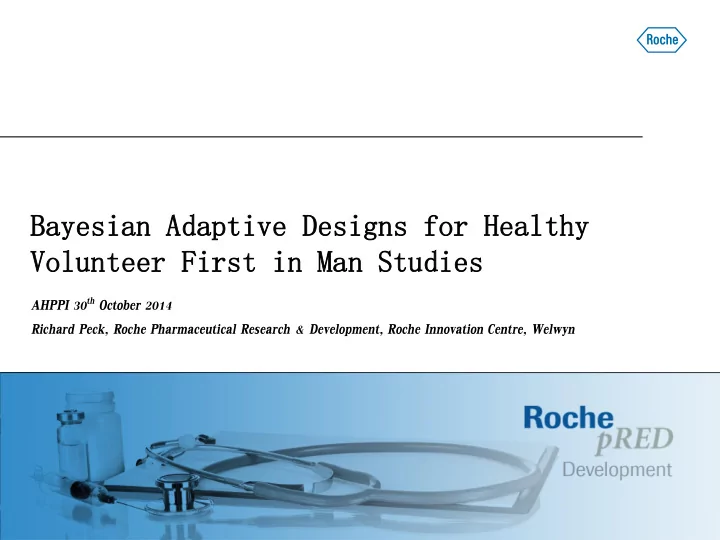

Bayesian Bayesian Adaptive Adaptive Designs for Healthy Designs for Healthy Volunteer Volunteer First First in Man Studies in Man Studies AHPPI 30 th October 2014 Richard Peck, Roche Pharmaceutical Research & Development, Roche Innovation Centre, Welwyn
Introdu duct ction on Adaptive Designs • use accumulating data to modify the design without introducing bias • are quite common for oncology first in man studies • Increase precision of MTD estimate • Limit patients dosed above MTD • Enable faster dose-escalation • Adaptations are driven by pre-planned statistical algorithms • “ Traditional ” first in man studies are flexible but not adaptive Bayesian Statistics • enable the calculation of probabilities based on the observed data and prior beliefs
Classic ical al sequenti tial al design 6A + 2P design – Max 8 cohorts Dose1 (N=6A+2P) doses: 0, 1, 3, 9, 25, 50, 100, 200, 400 Dose 2 (N=6A+2P) Stopping Rule: 3/6 (50%) with DLEs • MTD= dose Dose 3 (N=6A +2P) before stopping 4
Propose sed d adaptive e design 3A + 1P (possibly repeated) per cohort • Fewer subjects in low dose levels cohorts • Potential to increase subjects at informative dose levels Select next dose levels adaptively in order to estimate the Maximum Tolerated Dose (MTD): • Dose where DLE rate = 30% Stop when good precision on MTD or highest dose is safe.
Adaptiv ive e design features Design: • 3A + 1P initially • Possible doses: 0,1,3,6,9,20,25,40,50,75,100,150,200,300,400 Logistic Regression: • Model p(DLE) as function of dose MTD is dose where p(DLE)=30% Next dose level • Possible dose closest to predicted MTD • Maximum 3-fold increase in doses Example: predicted MTD=5.8 • Current dose=1 -> Next dose = 3 • Current dose=3 -> Next dose = 6
Adaptiv ive e design Cohort t expansio ion n & s study stopping g rules Switch from 3A+1P to 6A+2P • When the next dose predicted by the model is lower than the last dose given • In practice, we expand as soon as an MTD is found in the tested dose range. Stopping Rules • MTD Found • Precision of MTD is strong (CV ≤ 30%) or, • Any dose level is selected for the third time • MTD not Found • MTD is larger than highest possible dose (400mg) with high probability (>80%) • Maximum number of cohorts (16) 7
Simulat atio ion scenarios os Adaptive and sequential designs simulated for 7 scenarios 5000 simulations for each scenario and design = 70,000 trials
Adaptiv ive e designs identify y an M MTD more often %MTD estimated= % studies where CV(MTD)<30% or same dose chosen for 3 rd time - Larger value is better
Adaptiv ive e designs give more precise estimate e of MTD 10 Relative error = % error(estimated MTD – true MTD) - Smaller value is better
Adaptiv ive e designs need fewer subjects ts and expose e fewer to p poorly tolerate ted d doses N ° Subjects= total sample size. N ° overdosed = Subjects dosed >true MTD - Smaller value is better
Adaptiv ive e and s sequentia ial designs are s similar r duratio ion Duration= Number of dosing periods - Smaller value is better
Conclus usio ion Large-scale simulation study demonstrated the improved performance of an adaptive dose-escalation design compared to the standard approach in SAD trials Compared to standard approach • Better quality of MTD finding • Decrease in number of subjects • Comparable duration 13
Next steps Implement • Two adaptive SAD studies completed • More planned • Publications expected next year Simulated crossover/leap frog design • Challenges dealing with bias from dropouts • Publication in preparation Post-doc to develop methods for Bayesian adaptive MAD studies • First publications submitted/in press Mueller et al, J Cardiovasc Pharmacol, 2014;63:120-131
Recommend
More recommend